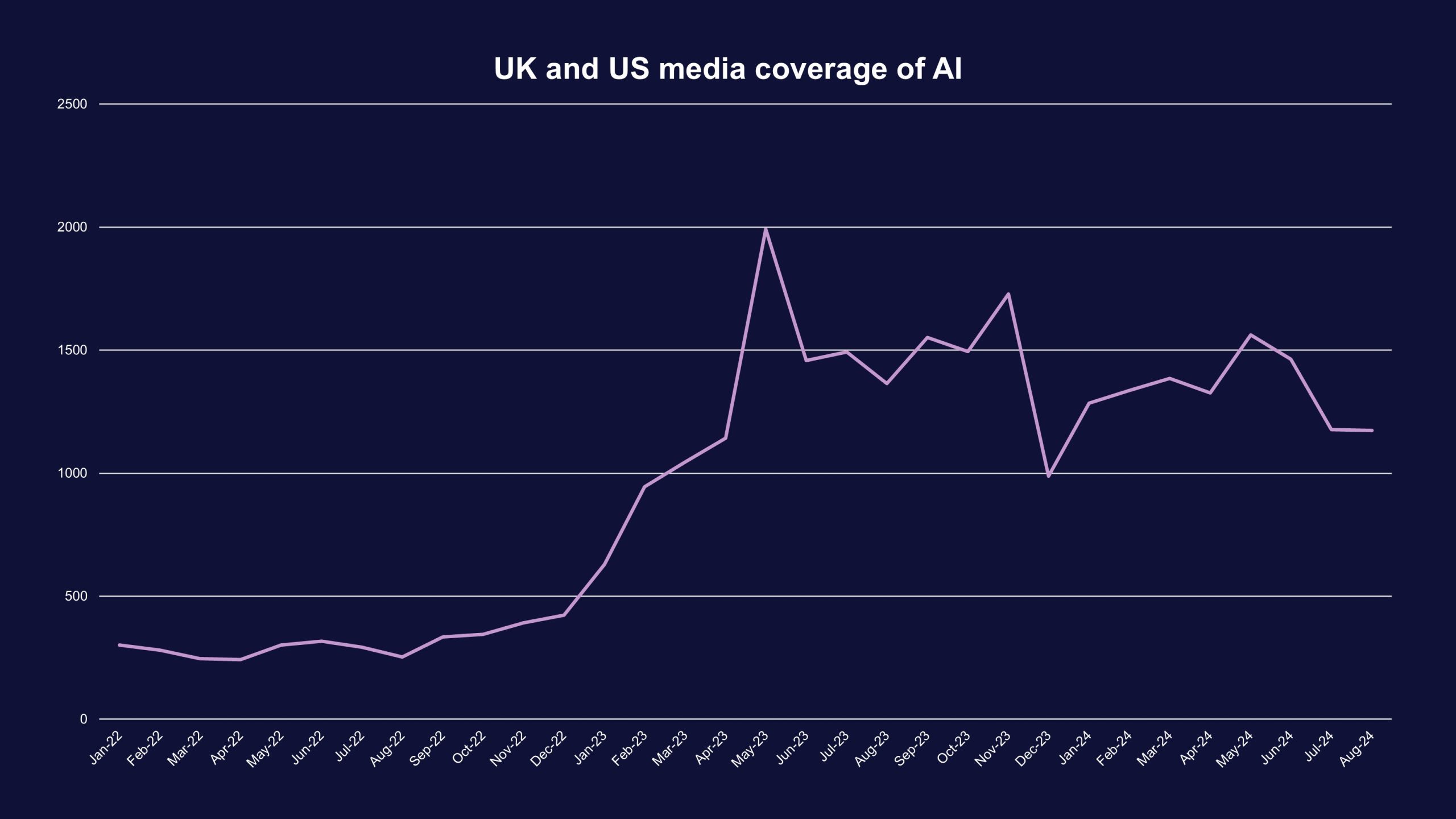AI in the media: from hype to humdrum?
September 30, 2024
It’s hard to believe that it’s now almost two years since the launch of Chat GPT.
Prior to November 2022, AI was largely confined to the realm of futurists, science fiction and academia. That all changed with OpenAI’s venture. AI became an accessible, ‘off the shelf’ product, ready to be used (and, potentially abused).
The implications for corporate reputation, and for the professional communicators tasked with its care, have been significant.
Scratch that. They’ve been seismic.
Media momentum
Here’s a proxy illustration of the point, if it needed reinforcing at all.
In 2023, mentions of artificial intelligence in the mainstream UK and US news publications increased 325% compared to 2022 (according to analysis by Infinite Global).
Reporting reached fever pitch in May 2023 as governments around the world raced to respond (including at the G7 summit that month); Nvidia share prices leaped amid predictions of an AI boom; and cracks started to emerge in the hopes for AI as Hollywood writers began their strike while BT announced plans to cut 55,000 jobs to be replaced by AI.

Hyped up
May 2023 was peak hype, both positive and negative. And hype is a useful word here.
According to the latest 2024 Gartner Hype Cycle, Generative AI (let’s separate that from AI generally for a moment) is currently starting its descent into the ‘trough of disillusionment’. This is where interest in a technology wanes as failures emerge.
From this point, technologies rise up the Hype Cycle along the gradual ‘Slope of enlightenment’ as benefits begin to crystallise, before the ‘plateau of productivity’ is reached and technological adoption becomes ubiquitous.
The Hype Cycle provides a view of the maturity and adoption of a technology. But media, as PR practitioners know, can provide a similar view – it may even be more current.
Mapping the media landscape
The news agenda, as we know, is fickle. The clue is in the name. It craves newness, urgency, tension and conflict.
Mapping the Hype Cycle against actual media reporting is therefore informative, and provides PR practitioners with an interesting insight into press and public interest in AI, the trajectory for sentiment and the landscape for communications.
Was AI used in the production of this blog?
Disclaimer, I asked ChatGPT to provide the data points in order to plot the shape of the Gartner Hype Cycle on the graph

If we assume that November 2022 and the launch of Chat GPT signifies the Gartner ‘Innovation trigger’, and May 2023 signifies the ‘Peak of inflated expectations’ as press reporting surged, a picture begins to build that implies that, so far as media and public interest goes, we are now approaching the ‘Plateau of productivity’.
This follows the ‘Trough of disillusionment’ which, interestingly, may have an inverse relationship with media interest. Media loves a ‘bad news’ story after all. November 2023, about the point that we would expect the ‘Trough’ to set in, saw a second surge in reporting, primarily driven by the departure of Sam Altman from Open AI (and his rapid return).
An article published by Forbes at the time argued that Altman’s departure, “could undermine the general confidence which boards have in the future of AI for their own company.”
Disillusionment indeed.
Adoption and ubiquity
Well, what now?
Put simply, AI maturity and adoption is now at a level where it is less likely to cause rapid surges in media reporting, and instead remain an ever-present part of the news agenda albeit at lower and more stable levels compared to the heights of 2023 and the early days of Chat GPT.
This is mirrored by increasing and more sophisticated regulation. If the regulators are catching up, ubiquity is not far away.
This has implications for brands and communicators.
AI adoption is becoming more ‘business as usual’, and that means fewer opportunities to cut through the noise and to use AI as a differentiator. For many businesses, an AI strategy (of some sort) has become table stakes.
At the same time, forgiveness will be hard to come by for missteps. We’re past the ‘messing around’ stage of AI.
The risks of mis-use are well known – from algorithmic bias and black box decisions to intellectual property infringement and data security. Loss of brand trust is a significant threat.
Reputations are on the line, and effective communicators, and communications (yes, no doubt supported by AI), will be essential.
Download your free AI Reputation Risk Map



